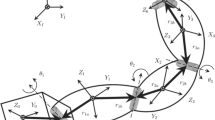Abstract
Free-floating space manipulator systems include at least one manipulator mounted on an unactuated spacecraft. It is known that such systems exhibit nonholonomic behavior due to angular momentum conservation. In this paper, the initial angular momentum of the system is not assumed to be zero and its influence on system behavior is studied. In contrast to the case of zero initial momentum, in the presence of momentum, the manipulator end effector in general cannot remain at a given location for indefinite time. The paper studies the conditions under which this is possible, rendering the end-effector immune to angular momentum accumulation. The relevant kinematics and dynamics are studied in 2D and 3D systems, and workspace subsets, where the end effector can remain fixed, are identified. Examples illustrate the validity of the results.
Similar content being viewed by others
References
Yoshida K, Hashizume K, Abiko S (2001) Zero reaction maneuver: validation with ETS-VII space robot and extension to kinematically redundant arm. In: Proceedings of IEEE international conference on robotics and automation (ICRA ‘01). Seoul, Korea, pp 441–446
Ogilvie A, Allport J, Hannah M, Lymer J (2008) Autonomous satellite servicing using the orbital express demonstration manipulator system. In: Proceedings of 6th international symposium on artificial intelligence. Robotics and automation in space. i-SAIRAS, Hollywood, USA, pp 26–29
Papadopoulos E (1993) Nonholonomic behavior in free-floating space manipulators and its utilization. In: Zexiang L, Canny JF (eds) Nonhonomic motion planning. Kluwer Academic, Boston, pp 423–445
Vafa Z, Dubowsky S (1990) On the dynamics of space manipulators using the virtual manipulator, with applications to path planning. Space Robot J Astron Sci 8(4): 441–472
Papadopoulos E, Dubowsky S (1993) Dynamic Singularities in Free-floating Space Manipulators. J Dyn Syst Meas Control Trans ASME 115(1): 44–52
Papadopoulos E, Dubowsky S (1991) On the nature of control algorithms for free-floating space manipulators. IEEE Trans Robot Autom 7(6): 750–758
Umetani Y, Yoshida K (1989) Resolved motion rate control of space manipulators with generalized Jacobian matrix. IEEE Trans Robot Autom 5(3): 303–314
Caccavale F, Siciliano B (2001) Kinematic control of redundant free-floating robotic systems. J Adv Robot 15: 429–448
Franch J, Agrawal S, Fattah A (Oct. 2003) Design of differentially flat planar space robots: a step forward in their planning and control. In: Proceedings of 2003 IEEE/RSJ international conference on intelligent robots and systems. Las Vegas, Nevada, pp 3053–3058
Agrawal S, Pathak K, Franch J, Lampariello R, Hirzinger G (2009) A differentially flat open-chain space robot with arbitrarily joint axes and two momentum wheels at the base. IEEE Trans Autom Control 54(9): 2185–2191
Tortopidis I, Papadopoulos E (2007) On point-to-point motion planning for underactuated space manipulator systems. Robot Auton Syst 55(2): 122–131
Dimitrov D, Yoshida K (Oct. 2006) Utilization of holonomic distribution control for reactionless path planning. In: Proceedings of 2006 IEEE/RSJ international conference on intelligent robots and systems. Beijing, China, pp 3387–3392
Dimitrov D, Yoshida K (2005) Utilization of distribution momentum control for planning approaching trajectories of a space manipulator to a target satellite. In: Proceedings of the 8th international symposium on artificial intelligence. Robotics and automation in space, i-SAIRAS. Munich, Germany
Xu W, Li C, Wang X, Liu Y, Liang B, Xu Y (2009) Study on non-holonomic Cartesian path planning of a free-floating space robotic system. Adv Robot 23: 113–143
Matsuno F., Saito K (2001) Attitude control of a space robot with initial angular momentum. In: Proceedings IEEE international conference on robotics and automation (ICRA ‘01). Seoul, Korea, pp 1400–1405
Yamada K, Yoshikawa S, Fujita Y (1995) Arm path planning of a space robot with angular momentum. Adv Robot 9(6): 693–709
Nenchev D, Umetani Y, Yoshida K (1992) Analysis of a redundant free-flying spacecraft/manipulator system. IEEE Trans Robot Autom 8(1): 1–6
Dimitrov D, Yoshida K (2004) Utilization of the bias momentum approach for capturing a tumbling satellite. In: Proceedings of 2004 IEEE/RSJ international conference on intelligent robots and systems. Sendai, Japan, pp 3333–3338
Mita T, Hyon S, Nam T (2001) Analytical time optimal control solution for a two-link planar acrobot with initial angular momentum. IEEE Trans Robot Autom 17(3): 361–366
Papadopoulos E, Fragkos I, Tortopidis I (2007) On robot gymnastics planning with non-zero angular momentum. In: Proceedings of IEEE international conference on robotics and automation (ICRA ‘07). Roma, Italy, pp 1443–1448
Siciliano B, Sciavicco L, Villani L, Oriolo G (2009) Robotics modelling, planning and control. Springer, Berlin
Hughes CP (1986) Spacecraft attitude dynamics. Willey, New York
Meirovitch L (1970) Methods of analytical dynamics. McGraw Hill, New York
Goldstein H, Poole C, Safko J (2002) Classical mechanics, 3rd edn. Addison Wesley, New York
Author information
Authors and Affiliations
Corresponding author
Rights and permissions
About this article
Cite this article
Nanos, K., Papadopoulos, E. On the use of free-floating space robots in the presence of angular momentum. Intel Serv Robotics 4, 3–15 (2011). https://doi.org/10.1007/s11370-010-0083-2
Received:
Accepted:
Published:
Issue Date:
DOI: https://doi.org/10.1007/s11370-010-0083-2




